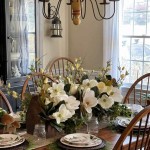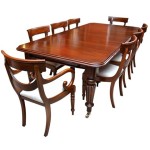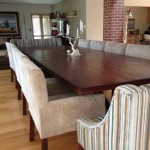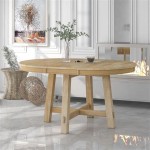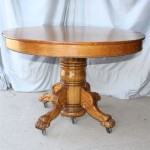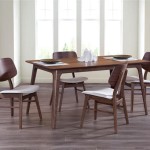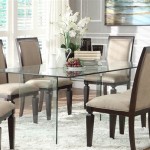Table Tennis Dining Room Table: A Multifunctional Furniture Marvel
The convergence of leisure and functionality in domestic spaces has led to the emergence of multifaceted furniture designs. One such design, the table tennis dining room table, offers a dual-purpose solution, transforming the traditional dining area into a space for recreation. This article will explore the characteristics, benefits, and considerations associated with this innovative piece of furniture.
Design and Construction of Table Tennis Dining Room Tables
Table tennis dining room tables are conceived to serve as both a standard dining surface and a regulation-size table tennis table. This requires a meticulous design process, balancing the aesthetic requirements of a dining table with the performance standards of the game. The construction typically involves a robust frame, often made of wood or metal, to ensure stability during both dining and gameplay. The playing surface is usually constructed from a high-density particleboard or MDF (Medium-Density Fiberboard) that has been carefully planed and finished to provide a consistent and predictable ball bounce. This surface is then coated with a specialized paint or laminate designed for table tennis, offering the requisite friction and visual clarity.
The dimensions of a standard table tennis table are 9 feet long, 5 feet wide, and 30 inches high. Dining tables, however, can vary significantly in size. Table tennis dining room tables attempt to meet these dimensions in either their expanded or primary configuration. Some models feature foldable halves or removable tops that convert the dining table into a regulation-size table tennis table. Others may have a slightly smaller playing surface to accommodate more compact dining room dimensions. The net and post system are usually detachable, allowing for seamless transition between dining and gameplay. These often attach using a clamp system designed to protect the table surface.
The aesthetic integration of the table tennis functionality within the dining table design is a crucial consideration. Manufacturers often employ clever design techniques to conceal the seams and hinges that enable the transformation. The table's legs are designed for stability and visual appeal, blending in with the overall décor of the dining room. Finishes range from traditional wood stains to modern lacquers, allowing the table to complement a variety of interior design styles. The goal is to create a piece of furniture that is both functional and aesthetically pleasing, seamlessly integrating into the dining room environment.
The materials used are also selected to withstand the wear and tear associated with both dining and table tennis. The surface must be resistant to scratches, spills, and impacts from table tennis balls and paddles. The frame must be strong enough to support the weight of diners and withstand the movements of players during a game. Durability is a key factor in the longevity and value of a table tennis dining room table.
Benefits of Owning a Table Tennis Dining Room Table
Table tennis dining room tables offer a multitude of benefits that extend beyond simple functionality. They represent a strategic utilization of space, an enhancement of social interaction, and a promotion of physical activity.
One of the primary advantages is the space-saving aspect. For individuals living in apartments or smaller homes, the ability to combine two essential pieces of furniture into one is invaluable. Instead of requiring separate spaces for dining and recreation, the table tennis dining room table offers a consolidated solution. This is especially beneficial in urban environments where space is at a premium. This consolidation frees up valuable square footage that can be utilized for other purposes, contributing to a more organized and spacious living environment.
Furthermore, the table serves as a catalyst for social interaction. A dining room is traditionally a gathering place for meals and conversation. The addition of table tennis transforms this space into a hub for friendly competition and active engagement. Families and friends can enjoy a meal together and then transition seamlessly into a table tennis match, fostering a sense of camaraderie and shared enjoyment. This is particularly beneficial for encouraging children and teenagers to engage in physical activity and spend time with family and friends in a fun and interactive way.
The health benefits of table tennis are also noteworthy. It is a low-impact sport that provides cardiovascular exercise, improves hand-eye coordination, and enhances mental alertness. Regular play can contribute to improved physical fitness and cognitive function. Having a table tennis table readily available in the home encourages spontaneous physical activity, making it easier to incorporate exercise into daily routines. This can be particularly appealing for individuals who find traditional gym workouts monotonous or inconvenient.
Beyond the practical and health-related benefits, the table tennis dining room table can also serve as a conversation starter and a unique design element. It adds a touch of personality and playfulness to the dining room, reflecting the owner's interests and lifestyle. Guests are often intrigued by the dual functionality of the table, leading to engaging conversations and memorable experiences. This can enhance the overall ambience of the dining room and create a welcoming and inviting atmosphere.
Considerations Before Purchasing a Table Tennis Dining Room Table
Before investing in a table tennis dining room table, several factors warrant careful consideration. These include the available space, the frequency of use, and the budget allocation.
The first and foremost consideration is the available space. While the table is designed to conserve space by combining two functions, it still requires adequate room for gameplay. The user must ensure that there is sufficient clearance around the table to allow for comfortable movement and unobstructed play. It is advisable to measure the dining room and simulate gameplay to determine if the table will fit comfortably without impeding movement or creating a cramped environment. Inadequate space can diminish the enjoyment of the game and potentially lead to injuries.
The frequency of use is another important factor. If the table is primarily intended for occasional table tennis games, a more affordable model with a simpler conversion mechanism may suffice. However, if the table is expected to be used frequently for both dining and table tennis, a higher-quality model with a more robust construction and a smoother conversion process is recommended. Investing in a durable and well-designed table will ensure its longevity and provide a more enjoyable experience over the long term. The balance between price and quality should reflect the anticipated usage patterns.
Budget is also a significant consideration. Table tennis dining room tables range in price from relatively inexpensive models to high-end designs with premium materials and features. The budget should be determined based on the anticipated frequency of use, the desired quality and aesthetics, and any specific features that are deemed essential. It is important to research different brands and models, compare prices, and read reviews to make an informed decision. Investing in a well-made table from a reputable manufacturer is often a worthwhile investment, as it will likely provide greater durability and performance over time.
Furthermore, the aesthetic integration of the table with the existing dining room décor should be considered. The table should complement the overall style and color scheme of the room, creating a cohesive and visually appealing environment. This may involve selecting a table with a specific finish, leg design, or overall aesthetic that aligns with the existing furniture and décor. A well-chosen table will enhance the beauty of the dining room, while a poorly chosen table can detract from its overall appeal. Consider the table as part of the overall design of the room, not just a functional object.
Finally, the ease of conversion between dining and table tennis modes should be evaluated. Some models have complex conversion mechanisms that require significant effort and time, while others have simpler and more user-friendly designs. The ease of conversion is an important factor to consider, especially if the table is expected to be switched between modes frequently. A table with a cumbersome conversion process can be frustrating to use and may discourage frequent gameplay. Therefore, it is advisable to choose a table with a conversion mechanism that is both easy to use and reliable.

Table Tennis Dining

The 3 In 1 Game Room Dining Table Air Hockey And Tennis

Waldersmith Table Tennis Dining The Games Room

A Luxury Ping Pong Dining Room Table

Hampton 3 In 1 Combo Game Table Billiards Ping Pong Dining Escalade Sports

Joola Berkshire Indoor Outdoor Table Tennis Usa

Plank And Hide Harper Ping Pong Table Robbies Billiards

Hampton 3 In 1 Pool Dining Table Tennis Recreation Specialists

Joola Berkshire Indoor Outdoor Table Tennis

A Ping Pong Table Or Foosball Ers Guide

